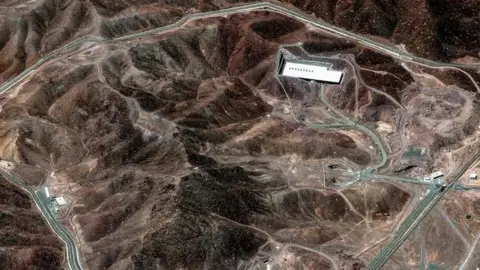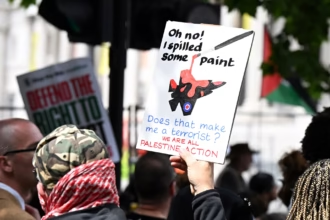 Reuters
ReutersUS President Donald Trump says the American military has completed strikes on three nuclear sites in Iran, marking a significant escalation in the ongoing war between Iran and Israel.
“We have completed our very successful attack on the three Nuclear sites in Iran, including Fordow, Natanz, and Esfahan. All planes are now outside of Iran air space,” he wrote on Truth Social.
Trump added that a “full payload of bombs” were dropped on Fordo, an enrichment plant hidden in a remote mountainside that is vital to Iran’s nuclear ambitions.
Israeli officials say they were in “full coordination” with the US in planning these strikes.
Iran could respond by targeting US military assets in the region. Its officials had earlier warned that they would retaliate and that any US attack risked a regional war.
Here is a breakdown of what we know so far.
How did this start?
Israel launched a surprise attack on dozens of Iranian nuclear and military targets on 13 June. It said its ambition was to dismantle its nuclear programme, which Prime Minister Benjamin Netanyahu said would soon be able to produce a nuclear bomb.
Iran insists its nuclear ambitions are peaceful. In retaliation, Tehran launched hundreds of rockets and drones towards Israel. The two countries have continued exchanging strikes since, in an air war which has now lasted more than a week.
Trump has long said that he is opposed to Iran possessing a nuclear weapon.
In March, US national intelligence director Tulsi Gabbard said that while Iran had increased its uranium stockpile to unprecedented levels, it was not building a nuclear weapon – an assessment that Trump recently said was “wrong”.
On the campaign trail, President Trump had criticised past US administrations for engaging in “stupid endless wars” in the Middle East, and he vowed to keep America out of foreign conflicts.
The US and Iran were in nuclear talks at the time of Israel’s surprise attack. Two days ago, President Trump had said he would give Iran two weeks to enter into substantial negotiations before striking – but that timeline turned out to be much, much shorter.
What has the US bombed, and what weapons did it use?
One of the sites the US attacked was a secretive nuclear site called Fordo. It is hidden away in a mountainside south of Tehran, and is believed to be deeper underground than the Channel Tunnel connecting the UK and France.
The uranium enrichment site is considered by experts to be vital to Iran’s nuclear ambitions.
Fordo’s depth below the Earth’s surface has made it difficult to reach with Israel’s weaponry. Only the US was considered to have a “bunker buster” bomb strong and large enough to destroy Fordo.
That American bomb is called the GBU-57 Massive Ordnance Penetrator (MOP). It weighs 13,000kg (30,000lb), and is able to penetrate about 18m of concrete or 61m of earth before exploding, according to experts.
Fordo tunnels are thought to be 80m to 90m below the surface, so the MOP is not guaranteed to be successful, but it is the only bomb that could come close.
US officials have confirmed to the BBC’s partner CBS News that MOPs were used in the strikes, with two for each target struck.
What is the impact on the ground in Iran?
It is unclear yet what damage the US attack has had on the nuclear enrichment facilities, or whether there are any injuries or casualties.
The deputy political director of Iran’s state broadcaster, Hassan Abedini, said Iran evacuated these three nuclear sites a “while ago”.
Appearing on state-run television, he said Iran “didn’t suffer a major blow because the materials had already been taken out”.
Iran has said that more than 200 people were killed since its latest round of fighting with Israel began, and more than 1,200 were injured.
Meanwhile, Israel is ramping up security in the wake of the US attacks on Iran’s key nuclear sites.
Israel has tightened its public security restrictions across the country, the Israeli Defense Forces (IDF) said.
The upgrade – including a “prohibition on education activities, gatherings, and workplaces” – comes after the US strikes on Iran.
How might Iran retaliate?
Iran has been weakened significantly by Israel’s attacks on its military bases so far, experts say, as well as the dismantling of its regional proxies in Lebanon (Hezbollah), in Syria and in Gaza (Hamas). But Iran is still capable of doing a considerable amount of damage.
Iranian officials warned the US against getting involved, saying it would suffer “irreparable damage” and that it risked an “all-out war” in the region.
It has threatened to target US bases in the region in retaliation. The US operates military sites across at least 19 regions in the Middle East, including in Bahrain, Egypt, Iraq, Jordan, Kuwait, Qatar, Saudi Arabia and the United Arab Emirates.
Among the most obvious targets for Iran is the US Navy’s 5th Fleet HQ at Mina Salman in Bahrain.
It could also target a critical shipping route known as the Strait of Hormuz, which links the Persian Gulf to the Indian Ocean and through which 30% of the world’s oil supply is transported. It could also attack on other sea routes that risk destabilising global markets.
Iran could also target the assets of nearby countries it perceives to be aiding the US, which risks the war spilling over to the entire region.
Does Trump need approval from Congress to send the US to war?
Under US law, the president does not have the sole power to formally declare war on another country. Only Congress – lawmakers elected in the House of Representatives and the Senate – can.
But the law also states that the president is the Commander in Chief of the armed forces. That means he can deploy US troops and conduct military operations without a formal declaration of war.
For example, Trump’s decision to conduct airstrikes in Syria in 2017 against the Assad regime did not require approval from Congress. Instead, Trump acted unilaterally, citing national security and humanitarian reasons.
Some lawmakers on both sides of the aisle have recently tried to limit Trump’s ability to order US strikes on Iran by pushing a war powers resolution through Congress, though it may take weeks before it is put to a formal vote, and such measures are more symbolic than substantive.









